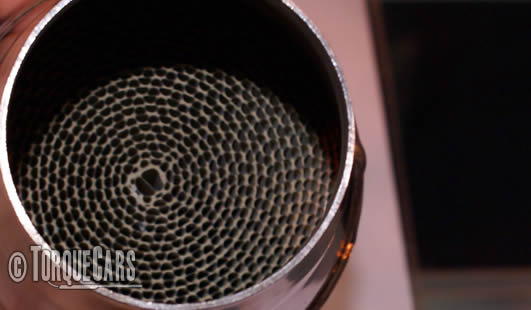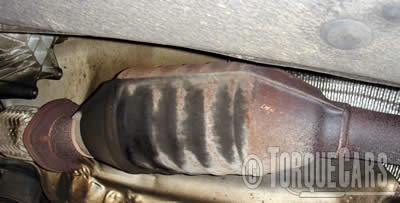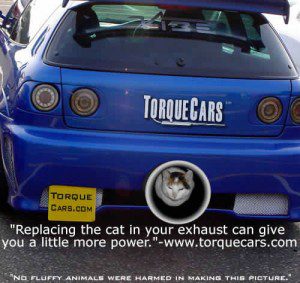Decat pipe or a Sport catalysts?
"A look at sports high flow cats and decats"
Catalysts are now an essential component in our modern everything must be green and environmentally friendly world. Firstly TorqueCars shall look at what a catalyst is what it does and how they work.
Since emissions regulations have become ever tighter, manufacturers have thought long and hard about catalysts with some even fitting 4 catalysts in the cars exhaust.
What is a catalyst?
A catalyst is actually a term used to explain anything which accelerates or performs a chemical reaction.
In a car the exhaust fumes are fed through a matrix of ceramic honeycomb lined with precious metals.

As the metals heat up they cause the gases flowing through them to react and change into less harmful substances.
Diesel catalysts:
In a 2 way diesel catalyst the CO2 and O2 into 2CO2 (carbon monoxide into carbon dioxide and partially burnt fuel into carbon dioxide and water.)
Diesels also have particulate filters to remove the small harmful particles that the exhaust contains.
The modern diesel engine actually runs really cleanly and few if any harmful products are thrown out of the exhaust, but this adds considerably to the maintenance costs of a vehicle, especially if a catalyst is not looked after.
Petrol catalysts:
3 way catalysts are used in modern petrol engines. These convert nitrogen oxide into nitrogen and oxygen, carbon monoxide into carbon dioxide, and hydrocarbons (partially burnt fuel) into carbon dioxide and water.
Some engines have multiple catalysts in each exhaust branch or even in series, or in some cases 2 then into 1.
A catalyst will die if it has unburned fuel entering it or it is used whilst it is cool. Therefore you should avoid jump starting a car with a catalyst and you must avoid short journeys.
We will then see if there are power gains from a sports or high flow cat and compare these with the removal of the catalyst altogether.
First the sports catalyst or sport cat. This has a much greater flow rate than a standard cat. It is constructed of the same materials but the chamber size and smoothness allow the exhaust gases to flow through more quickly.
In terms of efficiency, they will have the same effect as a standard cat on your vehicle's emissions.
They create less turbulence than a standard cat and have a finer matrix and therefore a greater internal surface area.
A sports catalyst is usually larger, to accommodate the higher flow rate required to keep performance levels.
Weight is also a consideration, and a sports cat will typically weigh less than a standard catalyst.
Most sports cats are a drop-in replacement although some offer a wider bore capacity so would better suit a car that has had a sports exhaust upgrade.
The power gains on smaller engines will be barely noticeable. On larger engines, you can see power gains of between 4 and 10bhp. Generally the more power the car is producing the greater the benefit will be from a sports cat.
What is a decat?
Specifically, a decat is the removal of one or all of a car's catalytic converters.
We should point out right at the outset is most countries, counties, and states the removal of a catalyst is illegal so should only be regarded as an off-road mod, but even tracks are insisting on pollution controls in some instances.
The de-cat pipe is a popular choice by many. This is a pipe which replaces the catalyst causing the exhaust fumes to flow freely.
Options include fitting a decat pipe in place of the catalyst creating a straight through exhaust, or taking out the internal catalytic converter from it's case and replacing the cat with the decat pipe.
A de-cat is a cheap option but there are some drawbacks. In some cars with O2 sensors, you will create a fault as far as the ECU is concerned at best lighting up a dash warning or at worse affecting the car's performance, forcing limp home mode or starting issues.
This may result in the car running in a fail-safe limp home mode.
Alternatively, the engine may decide that due to the amount of unburnt oxygen or remaining particulates it will use less fuel. This causes the engine to run lean.
Other cars have the Lambda or O2 sensor before the catalyst so will happily run with a de-cat pipe.
This though is an illegal modification in most countries where mandatory CO2 reduction systems are legally required. In a roadside spot check the car will fail its emissions test and you could risk prosecution.
Fitting a de-cat will again give a modest power gain but this will be similar to the power gain on offer with a sports cat. The sports cat has the benefit of being legal and keeps the car within its emission requirements.
We should point out that in some states and areas, it is illegal to replace any kind of pollution control system unless it was faulty, so this would technically rule out decats.

Many people subscribe to the popular misconception that a catalyst is the enemy of your cars power.
This is mainly due to the experience of people who had early catalysts fitted.
This was around 1992 in the UK. To cope with stringent emissions the manufacturers introduced the catalyst and use the Lambda sensor to measure emissions.
To get the emissions down and economy up most makers de-tuned their engines. When comparing a pre 1992 vehicle with an earlier one the earlier one would usually seem to be more powerful.
The post 1992 cars had better fuel economy. So in reality the catalyst had very little impact on the power of the car and most of this was down to the manufacturer's latest economy mapping.
Catalyst design and construction have improved greatly since its introduction so there is little to be gained for most modern cars.
 As the power gain is only going to be 4-10 bhp on all but the least powerful engines we cannot really recommend this modification unless your engine is already producing in excess of 200bhp or your power band is quite high up the rev range like in many VTEC engines.
As the power gain is only going to be 4-10 bhp on all but the least powerful engines we cannot really recommend this modification unless your engine is already producing in excess of 200bhp or your power band is quite high up the rev range like in many VTEC engines.
If however, your catalyst needs replacing we would strongly recommend the benefits of a sports catalyst, you might as well take the extra performance on offer and the cost is generally not much more than a standard OEM catalyst.
The prices of an original catalyst and a sports catalyst are very similar, so if you are spending the money you may just as well get a high-performance alternative.
Join us in our forum to discuss sports cat selection for your car with our enthusiastic and friendly car modders.
Please Check out my YouTube channel, we're regularly adding new content...
PLEASE HELP: I NEED YOUR DONATIONS TO COVER THE COSTS OF RUNNING THIS SITE AND KEEP IT RUNNING. I do not charge you to access this website and it saves most TorqueCars readers $100's each year - but we are NON PROFIT and not even covering our costs. To keep us running PLEASE Donate here
If you liked this page please share it with your friends, drop a link to it in your favourite forum or use the bookmarking options to save it to your social media profile.
Feedback - What do You Think?
Please use our forums if you wish to ask a tuning question, and please note we do not sell parts or services, we are just an online magazine.
Help us improve, leave a suggestion or tip
Please watch this video and subscribe to my YouTube channel.
3 Responses to “Decats & Sports catalysts”

 Click to accept YouTube Cookies & Play.
Click to accept YouTube Cookies & Play.
Do say 200 cell sports cats run hotter or cooler than OEM cats of say 600 cell?
It depends on the volume and size of the Catalyst. Faster flowing same internal volume will have less build up due to the lower surface area inside and the exhaust gases are not in contact with the cells for as long. But as soon as the volume and internal surface area changes you alter the thermal properties. Generally though the exhaust temps will be higher and cat surface temps lower when you use a sports cat, but this is negligible in my opinion.
In general, the more in output resistance the higher the temperature of the exhaust gases. In my opinion the biger flow to the outside of the engine the better foor the engine under some prerequisities (back pressure, size of the pipes, curves etc)